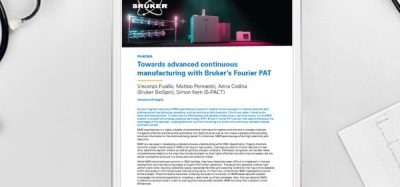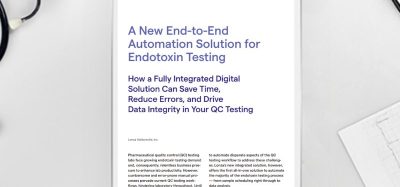Implementation of appropriate assays and HTS technologies in drug discovery
Posted: 9 May 2010 |
In this article, an overview regarding advances in assay formats for specific target classes and options that should be considered when considering hardware will be given. There has been a significant growth in the assay and automation technologies that are available for compound screening activities and it is essential to evaluate a variety of these before beginning a drug discovery program, the aims of these being to ensure the most relevant assay formats that are available are adopted.


In this article, an overview regarding advances in assay formats for specific target classes and options that should be considered when considering hardware will be given. There has been a significant growth in the assay and automation technologies that are available for compound screening activities and it is essential to evaluate a variety of these before beginning a drug discovery program, the aims of these being to ensure the most relevant assay formats that are available are adopted.
The use of these in compound screening activities should in turn enable the most appropriate Hits to be identified that should have the best possibility of progression into the subsequent phases of drug discovery programs. In addition, adopting the most appropriate hardware technologies that will allow effective miniaturisation and thus the subsequent associated cost savings for the compound screening activities to be realised is important.
Early stage small molecule drug discovery programs typically involve the following steps: (i) identification of a target that is considered to be causing a particular disease, (ii) generation of a reagent containing the target of interest, (iii) development of an appropriate assay to monitor target activity, (iii) utilisation of this assay in a screening campaign against a small molecule library and (iv) validation of the active compounds from the compound screening activities in the primary screening assay and an appropriate counter assay. After this, the Hits would be annotated with additional data from appropriate selectivity profiling, physicochemical properties, liability profiling, structural clustering and evaluating their Intellectual Property position1-2. This final data package would enable a data driven decision to be made as to which compounds should be progressed to the next stage of the drug discovery program (Validated Hit to Lead). Although these activities have traditionally been performed in the pharmaceutical industry, other organisations such as basic life science research laboratories have become actively engaged in drug discovery in an attempt to exploit their research efforts3.
With regards to the type of biological reagent containing the target that is employed in the assay development and subsequent screening campaign, a number of options should be considered. This can include those that make use of the target in isolation, in a recombinant cellular system or in a native environment such as a primary cell and the use of each of these types of reagents have advantages and disadvantages. In the case of employing the target in isolation, advantages include the ability to monitor the direct interaction of the compounds in the small molecule library with the target being investigated as there is no physical barrier such as a cell membrane separating them. A major disadvantage of using targets in isolation is that the environment usually does not resemble the physiological environment of the target. In the case of recombinant cellular systems, advantages of such assays include their ability to resemble to some extent physiological conditions; however, these often make use of cell lines in which the target being assayed is not normally found and target expression levels are usually significantly higher than under physiological conditions4. Many of these cell based assays make use of reporter systems that are prone to artefacts, thus it is essential to have in place appropriate counter assays to identify those compounds that act in a non-specific manner. Although primary cell based assays may resemble physiological conditions best, they usually provide phenotypic readouts and a variety of secondary assays are usually required to allow the identification of the mode of action of a compound identified as a Hit in the assay.
For most target classes, there are therefore a variety of assays that can be utilised in compound screening activities and it is important to choose the most relevant one rather than the easiest one to develop5. These assays are not usually as robust as the ones that utilise targets in isolation but the profiles of the Hits that are identified from such assays are more likely to translate in vivo. Sometimes a generic set of assay methodologies are applied; however, it is important that all options are considered at the assay development stage and that standard compounds and a subset of the small molecule library are evaluated in all assays and the actives that are identified are correlated.
In the case of kinases, a variety of assay formats are available and these can either be based on an activity or binding format6.
The traditional gold standard assays for kinases are radioactive in nature and make use of 33P-ATP. These have largely been superseded by other formats that have a much higher throughput and are less environmentally harmful. Activity assays include those that use a generic substrate such as myelin basic protein, a peptide that may be derived from a physio – logical substrate or the physiological protein substrate itself. These activity assays will enable both compounds that can modulate target activity by acting at the active centre as well as allosteric sites to be identified. Specific examples of kinase activity assays include those that make use of fluorescently labelled peptide substrates such as the Molecular Devices IMAP (available in fluorescence polarisation and TR-FRET format). Other kinase activity assay formats that should be considered are the ADP-Glo™ from Promega and the Transcreener® from BellBrook Labs, both of which measure ADP produced as a result of the phosphorylation of a substrate. Binding assays can make use of a known inhibitor (usually an ATP competitive inhibitor) of the kinase that is labelled with a suitable fluorophore. As the binding assays may only allow the identification of compounds that displace the tracer molecule, allosteric inhibitors may not be identified. An example of a binding assay is the LanthaScreen™ from Invitrogen. Cell based assays (either recombinant or primary cell based) should also be evaluated as these will provide useful information such as cell penetrance up front.
At some stage in the drug discovery program, the Hits from the screening campaigns will need to be evaluated in cell based assays and it is usually these types of assays that will have a significant influence on the compounds that are selected for further progression. An example of a cell based assay is the AlphaScreen® SureFire™ from Perkin Elmer. The development of such a wide repertoire of assays as described above for a single drug discovery program is not common and all too often the simplest assay is adopted. However, with the ability to now purchase assay kits for a range of target classes, it is possible that a number of assays can be evaluated in a reasonable timescale and cost. These however, need to be validated to an extent where they can be used with confidence and this is typically done by comparing the profiles of a range of standard compounds with different mechanisms of action. In the case of kinases, the development of the 4G10 anti-phosphotyrosine antibody has revolutionised their study. This has proved to be an important tool for research in a variety of areas, but in particular cellular signal transduction through tyrosine phosphorylation in proteins. It has been used to allow the development of assays to detect protein phosphorylation events in cells such as the Meso-Scale Discovery platform however, this requires specially manufactured microtitre plates. Other assay formats that can detect phosphorylation events that offer advantages over the Meso-Scale Discovery platform include TR-FRET and AlphaScreen® that can make use of phosphotyrosine antibodies such as the 4G10 as well as PY20 and PT66 antibodies. These assays are now commonly employed in small molecule screening campaigns for kinases, as suitable antibodies are commercially available in a variety of coupled forms e.g. agarose, biotin, fluorescein, allophycocyanin thereby allowing assay development times to be reduced significantly.
In the case of protease enzymes, activity assays are mainly employed in drug discovery programs and these make use of appropriately labelled generic peptides, physiological substrate derived peptides or the physiological protein substrates themselves. As with kinases, the use of peptide based substrates may bias the types of compounds that are identified from such screening campaigns7-10. Traditional assays for protease enzymes make use of non-labelled peptides and only have a low throughput capacity.
The above examples illustrate the wide range of assays available for the kinase and protease enzymes target classes. Thus, as there is an ever increasing range of assay technologies available for these as well as most target classes, it is essential to select a relevant format when initiating a drug discovery program.
With regards to actually performing small molecule screening campaigns, apart from the reagent that contains the target of interest, other pre-requisites include the ability to access a small molecule library, suitable hardware and software to carry out the screen and analyse the data that is generated. As the current drug discovery landscape is changing dramatically, academia that have historically been rich in a supply of targets implicated in drug discovery have become actively engaged in exploiting their internal basic life science research. In many cases, academic laboratories have installed screening infrastructure. The hardware that is adopted should ideally be user friendly to allow multiple users who are not necessarily experts in operating it can do so effectively. The options available that should be considered depend mainly on the number of compounds that are to be screened. Screening assays are typically run in 96, 384 or 1,536 microtitre plate formats and the final choice depends on a variety of factors such as the robustness of the assay, cost effectiveness of miniaturisation and reagent availability. Many academic assays are in 96 well format and miniaturisation into 384 well microtitre plate format are usually readily achievable11-12.
Having established an assay, the screening campaign can commence. For a typical 10,000 compound screen in singlicate, in the region of thirty 384 well microtitre plates would be required, which is a reasonable number of plates that can be handled manually. If the screen yields a Hit rate of one per cent, approximately 100 Hits would be identified whose activities would need to be confirmed and evaluated in subsequent full-curve experiments. For larger libraries of compounds that need to be screened, automated platforms should be considered. These can vary from bulk reagent dispensers configured with a stacker that would allow the automated transport of microtitre plates. These would then need to be manually moved to another workstation where further bulk reagent additions can be made or to a reader workstation to monitor the effects of compounds on the target. In the case of screening larger libraries of compounds >50,000, manual screening becomes cumbersome and prone to errors. Thus, a fully automated solution should be sought. This can range from the adoption of bulk liquid handlers with stackers with robotic arms that can allow the movement of microtitre plates to other places. Automated bulk liquid dispensers should allow for a high level of integrity, reliability and reproducibility of tasks13. These solutions, despite being relatively expensive, will reduce the need to have staff perform routine repetitive tasks and instead can engage in more stimulating activities. In these situations, it is imperative that maximum use is made of such expensive capital investments that are made so to ensure optimal return on investment. Adopting technologies such as High Content Screening technologies is also extremely useful, in particular in secondary screening.
Conclusions
The types of assays available for targets pursued in drug discovery have increased significantly recently and the researcher is often spoilt for choice as to which one to choose. In addition, the screening platforms in drug discovery have also undergone a revolution. This has included compound handling and dispensation technologies, liquid handlers and detectors (traditional plate readers and High Content Imagers). For cell based assays, frozen cell assays are now well established that enable a single cell batch to be prepared in advance and utilised for an entire screening campaign which prevents a batch-to-batch variation in signal and/or pharmacology against standard compounds.
References
- Kaitin, K. I. Deconstructing the drug development process: the new face of innovation. Clinical Pharmacology and Therapeutics, 2010, 87:356-361.
- Bass, A. S., Cartwright, M. E., Mahon, C., Morrison, R., Snyder, R., McNamara, P., Bradley, P., Zhou, Y. Y. and Hunter, J. Exploratory drug safety: a discovery strategy to reduce attrition in development. Journal of Pharmacological and Toxicological Methods, 2009, 60:69-78.
- Frearson, J. A. and Collie, I. T. HTS and hit finding in academia-from chemical genomics to drug discovery. Drug Discovery Today, 2009, 14:1150-1158.
- Eglen, R. M., Gilchrist, A. and Reisine, T. An overview of drug screening using primary and embryonic stem cells. Combinatorial Chemistry & High Throughput Screening, 2008, 11:566-572.
- An, W. F. and Tolliday, N. J. Introduction: cell-based assays for highthroughput screening. Methods in Molecular Biology, 2009, 486:1-12.
- Jia, Y., Quinn, C. M., Kwak, S. And Talanian, R. V. Current in vitro kinase assay technologies: the quest for a universal format. Current Drug Discovery Technologies, 2008, 5:59-69.
- Białas, A. and Kafarski, P. Proteases as anti-cancer targets-molecular and biological basis for development of inhibitor-like drugs against cancer. Anti-Cancer Agents in Medicinal Chemistry, 2009, 9:728-762.
- Mancini, F., Naldi, M., Cavrini, V. and Andrisano, V. Multiwell fluorometric and colorimetric microassays for the evaluation of beta-secretase (BACE-1) inhibitors. Analytical and Bioanalytical Chemistry, 2007, 388:1175-1183.
- Grant, S. K, Sklar, J. G. and Cummings, R. T. Development of novel assays for proteolytic enzymes using rhodamine-based fluorogenic substrates. Journal of Biomolecular Screening, 2002, 7:531-540.
- Thiele, A., Zerweck, J. and Schutkowski, M. Peptide arrays for enzyme profiling. Methods in Molecular Biology, 2009, 570:19-65.
- Mayr, L. M. and Bojanic, D. Novel trends in high-throughput screening. Current Opinion in Pharmacology, 2009, 9:580-588.
- Wunder, F., Kalthof, B., Müller, T. and Hüser, J. Functional cell-based assays in microliter volumes for ultra-high throughput screening. Combinatorial Chemistry & High Throughput Screening, 2008, 11:495-504.
- Michael, S., Auld, D., Klumpp, C., Jadhav, A., Zheng, W., Thorne, N., Austin, C. P., Inglese, J. and Simeonov, A. A robotic platform for quantitative high-throughput screening. ASSAY and Drug Development Technologies, 2008, 6:637-657.
About the author
Dr Sheraz Gul is Vice President and Head of Biology at European ScreeningPort, Hamburg, Germany. He is responsible for the management and development of Medium and High Throughput Screening activities for academic partners across Europe. He has 12 years research and development experience in both academia (University of London) and industry (GlaxoSmithKline Pharmaceuticals). This has ranged from the detailed study of catalysis by biological catalysts (enzymes and catalytic antibodies) to the design and development of assays for High Throughput Screening for the major biological target classes. He is the co-author of numerous papers, chapters and the Enzyme Assays: Essential Data handbook.
email: [email protected]








